
The Onboarding Crisis That's Costing Companies Millions
Employee onboarding has reached a breaking point. Despite its critical importance, only 12% of employees believe their organization delivers a good onboarding process, while 80% of new hires who feel undertrained from poor onboarding plan to quit. With the cost of replacing a single employee ranging from half to twice their annual salary, organizations can no longer afford to overlook this foundational experience. (Whale, Articulate).
The statistics paint a stark picture: 70% of new hires decide whether a job is the right fit within the first month, and 30% of employees leave their jobs within 90 days. Yet companies with effective onboarding processes see dramatic improvements — 82% better new hire retention and 70% increased productivity. (Insight Global, Cerkl, StrongDM, Whale)
Why Traditional Onboarding Falls Short in 2025
Traditional onboarding approaches are failing modern organizations in three critical ways that no amount of good intentions can fix.
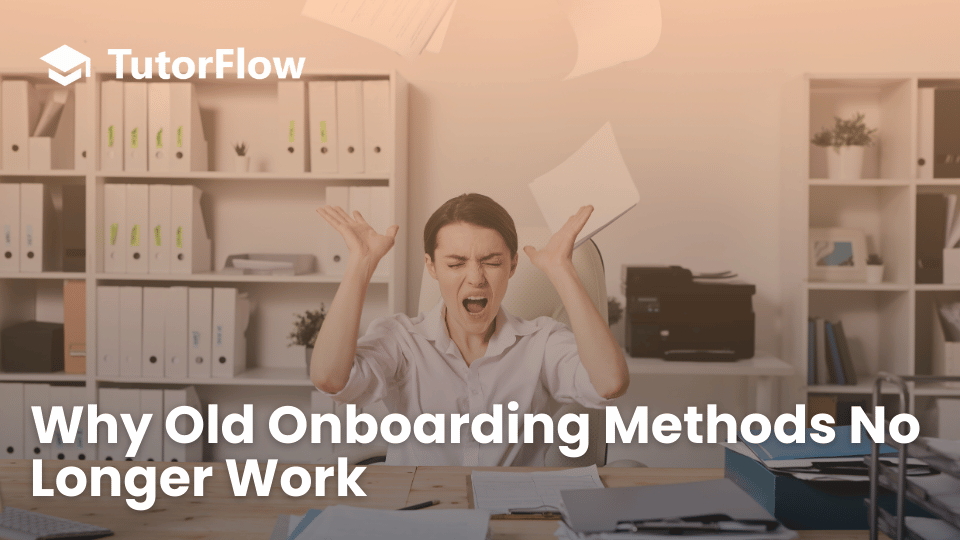
Administrative Overwhelm Drowns New Hires
The typical new employee experience begins with information overload: stacks of paperwork, lengthy policy manuals, and rushed video calls that leave them feeling more confused than welcomed. 48% of new hires say they didn't get enough training after onboarding, creating a foundation of uncertainty that can persist for months.
"Information overload happened to be our deadliest onboarding mistake."
— Ketan Kapoor, CEO and Co-Founder of Mettl (BambooHR)
This overwhelming approach stems from trying to frontload everything into the first few days. Instead of building confidence and clarity, traditional onboarding often creates anxiety and disengagement from day one.
One-Size-Fits-All Approaches Miss Individual Needs
Every new hire comes with different backgrounds, learning preferences, and role-specific requirements. Yet most onboarding programs treat everyone identically, delivering generic content that may not be relevant to their specific position or department.
"It's unrealistic to anticipate new hires to stop what they're doing and search for the nearest employee development LMS training terminal. Different people process information in different ways. As a result, providing a variety of resources that accommodate various learning styles can enhance memory and recall."
— Jeff Romero, Founder of Octiv Digital (BambooHR)
This lack of personalization means critical role-specific knowledge gets buried in generic company information, while new hires struggle to understand how their unique skills and responsibilities fit into the bigger picture.
Manual Processes Create Bottlenecks and Inconsistencies
HR teams are stretched thin managing manual processes that don't scale. When every onboarding step requires human intervention — from scheduling meetings to tracking progress — bottlenecks inevitably form. Companies save about $18,000 yearly through AI onboarding automation, but more importantly, they create consistent experiences that don't depend on individual availability or memory.
"Inaccessible onboarding technology and team members too busy to engage with the new hire makes for a very bad first day of onboarding. When passwords and usernames aren't readily available, a computer or cell phone aren't ready, and team members are too busy to introduce themselves or answer questions, onboarding becomes a chaotic, unorganized, unwelcoming experience for the new hire."
— Tiffany E. Slater, PhD, SHRM-SCP, CEO and Senior HR Consultant, HR TailorMade (BambooHR)
Manual processes also lead to inconsistent experiences where some new hires receive comprehensive support while others fall through the cracks, creating unequal foundations for success.
The AI Revolution: Transforming Onboarding from Burden to Advantage
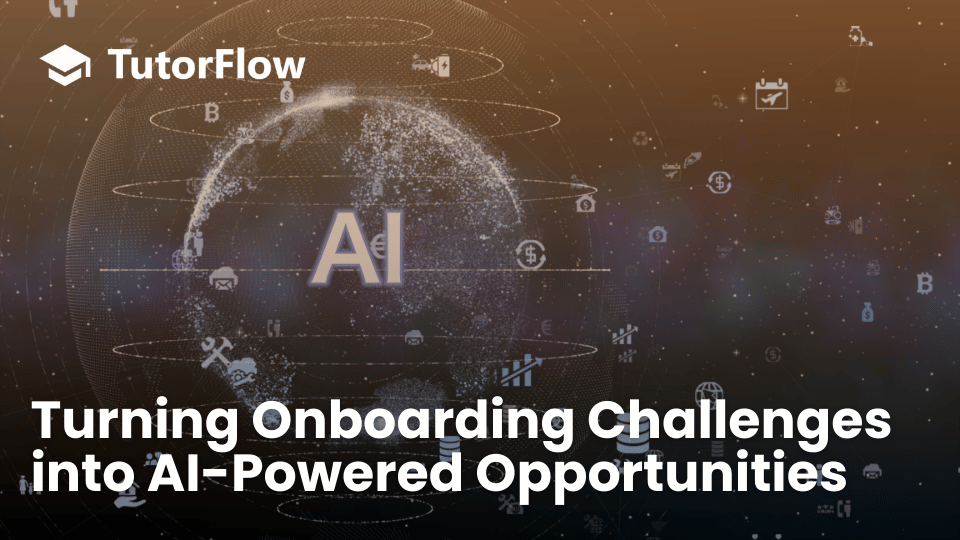
Artificial intelligence is fundamentally reshaping how organizations approach employee onboarding, turning what was once a resource-intensive challenge into a strategic advantage. 45% of HR professionals already use AI-driven onboarding, and another 25% will start using it in 2024.
Automated Course Creation at Lightning Speed
AI-powered platforms can now generate comprehensive onboarding courses in under 30 minutes. By analyzing your company's existing materials — white papers, policies, training documents, and internal resources —AI creates structured, engaging courses tailored to specific roles and departments.
This isn't just about speed; it's about consistency and quality. AI ensures that every new hire receives the same high-standard introduction to your organization, regardless of when they start or which department they join. Companies using AI for content creation have reported cost savings of up to 35% and a reduction in training video production time by 62%.
"The first rule of any technology used in a business is that automation applied to an efficient operation will magnify the efficiency. The second is that automation applied to an inefficient operation will magnify the inefficiency."
— Bill Gates (Akasa)
Personalized Learning Paths That Adapt in Real-Time
Modern AI systems analyze individual learning patterns, role requirements, and performance data to create truly personalized onboarding experiences. Instead of generic modules, new hires receive content tailored to their specific position, prior experience, and learning pace.
AI-driven learning paths accelerate employee development by providing personalized learning modules, ensuring that each person receives exactly what they need when they need it. This approach recognizes that a software engineer's onboarding journey should look fundamentally different from a sales representative's path.
Intelligent Support Systems That Never Sleep
AI chatbots and virtual assistants provide 24/7 support, answering common questions instantly and escalating complex issues to human experts when needed.
"40% of new hires say getting a response from HR about their question takes too long."
— Digitate (PeopleSpheres)
These systems learn from each interaction, becoming more effective over time and reducing the burden on HR teams while improving the new hire experience.
Measuring Success: The ROI of AI-Powered Onboarding
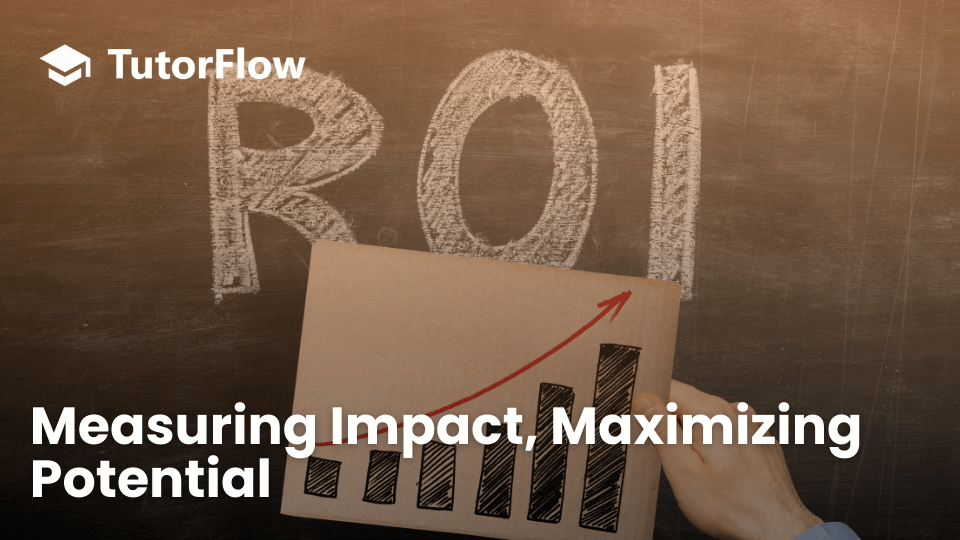
Retention Improvements That Transform Your Bottom Line
Organizations implementing AI onboarding systems see 25% increase in retention rates and 30% reduced likelihood of new hires quitting within their first year.
"If a new employee doesn't feel welcome or isn't given direction on their first day, it's an indicator their colleagues, manager, and company haven't invested time to set the employee up for success. The employee, already feeling disengaged, may already decide it's time to start looking for a new job. A strong onboarding program makes that much of a difference in an employee's desire to stay at a job."
— Eric Mochnacz, Director of Operations at Red Clover HR (BambooHR)
Productivity Gains That Accelerate Business Results
AI-powered onboarding doesn't just help people stay — it helps them contribute faster. Companies that use AI-powered onboarding platforms can reduce time-to-productivity by up to 30%.
IBM saw a 25% reduction in time-to-productivity after implementing AI onboarding solutions, while SAP identified a 30% increase in new hire engagement through personalized onboarding programs.
Cost Savings That Fund Future Growth
Beyond the direct savings from reduced turnover, AI onboarding creates operational efficiencies that compound over time. HR teams using AI for onboarding report a 53% reduction in onboarding time.
The scalability factor is particularly significant. With automation, you can save money by allowing HR representatives to focus on more important manual tasks while providing the scalability you need to onboard multiple employees simultaneously.
Real-World Implementation: How Leading Organizations Deploy AI Onboarding
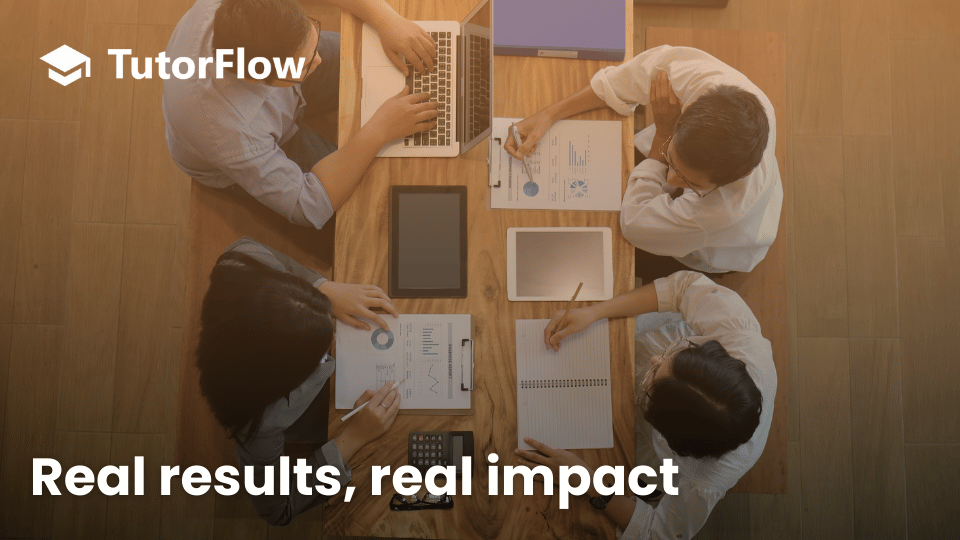
The Microsoft Approach: Personalized Learning at Scale
Microsoft has implemented an AI-driven onboarding program that uses machine learning to personalize experiences based on role, department, and individual learning patterns. Their system has seen a significant reduction in time-to-productivity by delivering exactly the right content at the right time.
The key to Microsoft's success lies in their integration approach, rather than replacing human interaction. AI handles administrative tasks and content delivery, freeing managers to focus on relationship.
The Google Model: Continuous Optimization
Google's 90-day onboarding process incorporates AI to continuously analyze and optimize the experience. Their approach demonstrates how companies with effective onboarding programs see a 50% higher retention rate, with AI providing the data and insights needed to make ongoing improvements.
Google's success stems from treating onboarding as an iterative process, using AI analytics to identify what works and what doesn't, then automatically adjusting future experiences based on these insights.
Building Your AI-Powered Onboarding Strategy
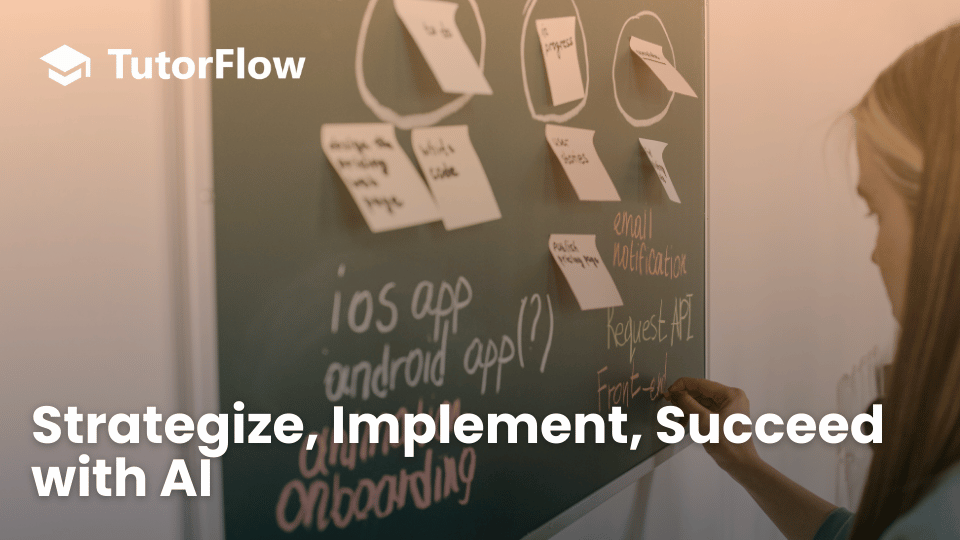
"AI will not replace humans, but those who use AI will replace those who don't."
— Ginni Rometty, Former CEO of IBM (Time)
Phase 1: Foundation and Assessment
Begin by auditing your current onboarding process to identify the biggest pain points and opportunities. Identify skill gaps within your organization to ensure your employees get relevant and effective training, and map out the specific challenges that AI can address.
Focus on areas where manual processes create bottlenecks or where inconsistent experiences harm new hire satisfaction. This assessment phase should involve both HR teams and new hire feedback to ensure you're solving real problems, not perceived ones.
Phase 2: Platform Selection and Integration
Choose an AI onboarding platform that integrates seamlessly with your existing HR infrastructure. Look for solutions that offer automated employee onboarding software with features like auto-assign tasks to HR, IT, and managers and send automatic reminders for pending forms, compliance training, or document uploads.
The most effective platforms combine AI capabilities with human oversight, ensuring that technology enhances rather than replaces the personal connections that make onboarding meaningful.
Phase 3: Content Development and Customization
Work with your chosen platform to develop role-specific content that reflects your company culture and values. AI can generate entire courses, including text, images, and videos, tailored to specific learning objectives and audience needs.
"We use an automated process for our onboarding that gets all of the administration work out of the way before the first day. All documents are signed and the information is collated so we can get on with the onboarding process without distraction."
— Heidi Brockman, Head of Human Resources at House Buyer Network (BambooHR)
This phase requires close collaboration between AI systems and subject matter experts to ensure accuracy, relevance, and alignment with your organizational goals.
Phase 4: Testing and Optimization
Launch with a pilot group to gather feedback and refine the experience before full deployment. Track key metrics, such as onboarding completion rates, new hire satisfaction, and time-to-productivity to measure success and identify areas for improvement.
Use this data to continuously optimize the experience, adjusting content, pacing, and delivery methods based on real-world results.
Overcoming Common Implementation Challenges
Balancing Automation with Human Connection
While AI excels at delivering information and managing processes, sensible HR teams will notice that the need for human interaction will always be there, and hence will make an effort towards keeping rites like intro meetings with the direct manager and other key team members.
"New employees are the lifeblood of any company, and the employee onboarding process is essential as it helps the new hires become acclimated to their job. A good beginning marks the best ending, and the same applies conversely. Employees who feel welcomed and supported are more likely to stay with the organization in the long run."
— Maria Ivanova, Founder of Mastermaid (BambooHR)
The most successful implementations use AI to handle administrative tasks and content delivery while preserving and enhancing opportunities for meaningful human connections.
Ensuring Content Quality and Accuracy
AI-generated content requires human oversight to ensure accuracy and cultural appropriateness. AI still struggles with understanding nuances like cultural biases, so there remains a crucial need for human oversight.
"Rather than wringing our hands about robots taking over the world, smart organizations will embrace strategic automation use cases. Strategic decisions will be based on how the technology will free up time to do the types of tasks that humans are uniquely positioned to perform."
— Clara Shih (Akasa)
Establish clear review processes where subject matter experts validate AI-generated content before it reaches new hires, ensuring that efficiency doesn't come at the cost of quality.
Managing Change Resistance
Some team members may resist AI implementation due to concerns about job displacement or technology complexity. Address these concerns by positioning AI as a tool that enhances rather than replaces human capabilities.
By leveraging AI content generators, organizations can revolutionize their corporate training and stay ahead of the curve in the rapidly evolving learning and development landscape.
The Future of AI-Powered Onboarding
As we look toward the future, several trends will shape the evolution of AI-powered onboarding:
Predictive Analytics will enable organizations to identify potential retention risks before they become problems, allowing for proactive interventions that keep valuable talent engaged.
Multilingual Capabilities will make global onboarding seamless, with AI automatically adapting content for different regions, languages, and cultural contexts.
Integration with Performance Management will create continuous learning journeys that extend far beyond the initial onboarding period, supporting career development and long-term engagement.
Taking Action: Your Next Steps
AI-powered onboarding is more than a process; it's the foundation for attracting, retaining, and developing top talent. The right AI tools can reduce administrative burden, personalize learning, and provide timely support to every new hire.
With platforms like TutorFlow, you can give new hires a consistent, engaging onboarding experience while freeing HR teams to focus on what matters most.
Do not let your organization fall behind. Start using AI-powered onboarding today to make every new hire feel supported, prepared, and ready to contribute from day one. See real examples here.
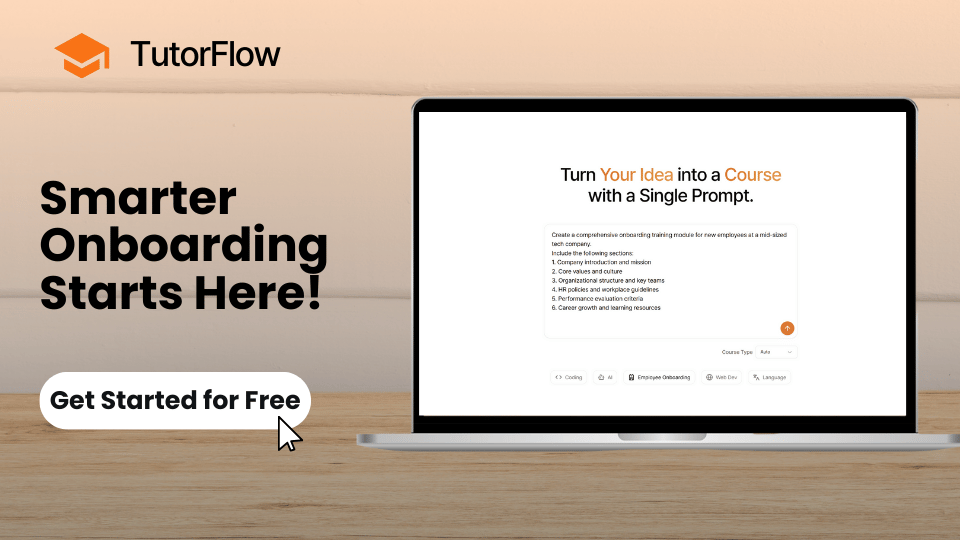
👉 Start Creating in Seconds with TutorFlow


